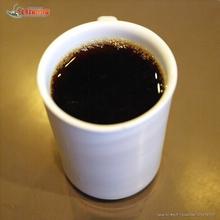An introduction to the characteristics of the manor producing area with a delicate fragrance of Tanzanian coffee flavor
The topography of Tanzania is high in the northwest and low in the southeast, showing a ladder shape. The eastern coast is a lowland, the western inland plateau accounts for more than half of the total inland area, and the East African Rift Valley runs from east to west from Lake Malawi to the north and south. The Kibo peak of Mount Kilimanjaro in the northeast is 5895 meters above sea level, which is the highest peak in Africa.
Climate
The eastern coastal areas and inland lowlands of Tanzania have a savanna climate, while the western inland plateau has a tropical mountain climate, with an average temperature of 21-25 ℃ in most areas. Zanzibar's more than 20 islands have a tropical maritime climate, hot and humid all the year round, with an annual average temperature of 26 ℃. Tanzania is rich in mineral resources. By 2014, the major minerals identified include gold, diamond, iron, nickel, phosphate, coal and various gemstones, ranking fifth in Africa in total. Tanzania's natural gas reserves are also huge. According to official data released by Tanzania, Tanzania has proven natural gas reserves of 44 trillion cubic feet, with total reserves expected to reach at least 200 trillion cubic feet. Tanzania's official capital is Dodoma, located at the eastern end of the southern highlands, 1115 meters above sea level and 400km from Dar es Salaam.
It is a transportation center city with a population of 300000.
Due to geographical location as well as economic and political reasons, people outside Tanzania believe that Dar es Salaam is the capital of Tanzania. In fact, Dar es Salaam is not the capital of Tanzania. It was the capital of German East Africa from 1891 to 1916. It was the capital of Tanganyika from 1961 to 1964 and later the capital of Tanzania. In 1974, the Tanzanian Parliament decided to move the capital to the inland town of Dorma.
The coffee beans produced here are all exported from Kilimanjaro, but apart from Mount Kilimanjaro, there are several major coffee-producing areas throughout Tanzania, there are more small farms in other areas, and most small farms also have a planting area of several hundred mu. Some have their own washing equipment and drying farms, but graded treatment still has to go through large-scale treatment plants. Tanzania has considerable historical experience in growing coffee, and even small farms can handle good quality coffee beans.
Drinking Tanzanian coffee, especially the small round bean peaberry, is always impressive. Coffee is like the simple, frank and enthusiastic national character of Tanzania. Its refreshing acidity and medium mellowness complement sweet citrus and floral aromas. This coffee tastes great whether it's a hot drink or iced coffee. With oranges or berries, it can show its bright flavor. You can experience that different ethnic groups produce different coffee flavors, while the same land is pregnant with coffee trees and people at the same time.
Mount Kilimanjaro in Tanzania is 5895 meters above sea level and connected to Mount Meru. It is the main production base of Kilimanjaro coffee. Mount Kilimanjaro is the highest peak on the African continent and the only snowy peak on the earth located on the equatorial line. It is "the roof of Africa" and "Snow White on the equator". The rich volcanic ash gives the coffee here a strong texture and soft acidity, with the characteristics of typical African coffee beans. Kilimanjaro AA is the highest grade of beans with high quality in all aspects. Medium or more moderate after baking has a strong aroma. Suitable for individual or iced coffee Arusha has become the most important coffee growing area in Tanzania with the geographical advantage of the highest mountain in Africa. The fertile volcanic soil gives the local coffee a strong texture and soft acidity. It is said that the coffee grown here exudes a delicate fragrance and contains a special aroma that makes people taste it. With the reputation of "coffee with the most African characteristics", Arusha has gathered many coffee plantations of different sizes and shapes, some of which are famous for coffee trees that are more than a century old; some manors have lived here after generations of immigrants and have been engaged in coffee cultivation for generations; some manors have recruited coffee growers from India, Northern Europe, Britain and other countries. These coffee farms, large and small, all have their own unique ways of operation. The Arusha Coffee Garden Hotel was built on a coffee plantation, and each hut is surrounded by clumps of coffee trees. If interested, hotel staff will be more than happy to take guests nearby for a free and in-depth coffee trip. In addition, coffee elements can be found everywhere in the room, the mini-bar has prepared roasted coffee beans and homemade biscuits, coffee-related books are placed on the desk, photos of plantations hang on the walls, and you can smell coffee when you fall asleep at night.

Important Notice :
前街咖啡 FrontStreet Coffee has moved to new addredd:
FrontStreet Coffee Address: 315,Donghua East Road,GuangZhou
Tel:020 38364473
- Prev

Rich aroma of Indonesian Manning Coffee Flavor and Taste characteristics of Fine Coffee
A number of scattered feudal kingdoms were established in the 7th century AD. Recorded dynasties include the death of the Buddhist Sri Buddha (mid-7th century-1293), who was conquered by Manabache, and the Kingdom of New Keshari, which controlled the Strait of Malacca (1222-1292), which led to the Yuan-claw War, and then the royal family established the most powerful Malacca in Indonesian history in Java with the help of the Yuan army.
- Next

Introduction to the characteristics of manor producing area with unique flavor of Indonesian civet coffee
The cat is lonely, nocturnal, alert, sensitive to hearing and smell, day and night, agile, sensitive, cunning and suspicious, so it is called fox cat. Hiding in thickets, grass, tree caves, soil caves and caves during the day, he began to move in the morning and dusk, often looking for food at the edge of the forest, near agricultural land, in valleys, or even near settlements, and returned to his habitat two or three hours later.
Related
- Detailed explanation of Jadeite planting Land in Panamanian Jadeite Manor introduction to the grading system of Jadeite competitive bidding, Red bid, Green bid and Rose Summer
- Story of Coffee planting in Brenka region of Costa Rica Stonehenge Manor anaerobic heavy honey treatment of flavor mouth
- What's on the barrel of Blue Mountain Coffee beans?
- Can American coffee also pull flowers? How to use hot American style to pull out a good-looking pattern?
- Can you make a cold extract with coffee beans? What is the right proportion for cold-extracted coffee formula?
- Indonesian PWN Gold Mandrine Coffee Origin Features Flavor How to Chong? Mandolin coffee is American.
- A brief introduction to the flavor characteristics of Brazilian yellow bourbon coffee beans
- What is the effect of different water quality on the flavor of cold-extracted coffee? What kind of water is best for brewing coffee?
- Why do you think of Rose Summer whenever you mention Panamanian coffee?
- Introduction to the characteristics of authentic blue mountain coffee bean producing areas? What is the CIB Coffee Authority in Jamaica?

